|
Diseases of Poultry
By Ivan Dinev, DVM, PhD
|
RIEMERELLA ANATIPESTIFER INFECTIONS

82.Riemerella anatipestifer (RA) infection is a contagious disease in domestic ducks, turkeys and other fowl. It is encountered as acute or chronic septicaemia and is characterized with serous fibrinous polyserosites. The respiratory tract could be also affected. The ducklings at the age of 18 weeks are especially susceptible. Clinically, sneezing, cough, trembling of the head and neck, ataxia and greenish diarrhoea could be present.

83. The most characteristic gross lesion is the deposit of fibrinous exudate on the pericardium, the liver capsule or air sacs. The chronic lesions affect the skin and the joints. Although a tentative diagnosis could be made on the basis of observed clinical symptoms and lesions, it is confirmed upon the isolation and identification of RA. The RA infection should be distinguished from septicaemiae due to P. multocida, E. coli, Salmonella etc. The treatment with antibiotics (Flumequine) and sulfonamides IJrimetoprim, Sulfadiazine) has a varying success.
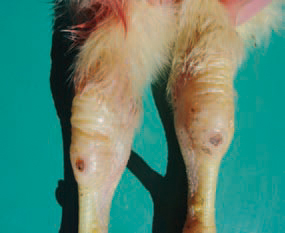

84. 85. Staphylococcus aureus infections are commonly seen in poultry. Usually, bones, tendon sheaths and joints, particularly coxofemoral and tibiotarsal joints are affected. The clinical signs include unilateral or bilateral lameness, reluctance to move and lying down. When the tibiotarsal joints are affected, swellings, fever and sometimes necroses of overlying tissues and purulent exudation are observed.
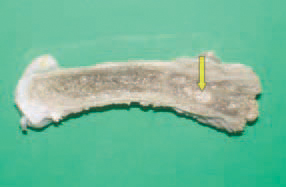

86. 87.As a sequel to septicaemia, osteomyelitis could occur. The lesions are usually detected in the region of the proximal femur, where inflammatory necrotic foci in the bone marrow and partial or complete fracture of the femoral head are observed.
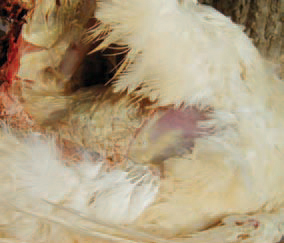
88. The outcomes of skin injuries are the appearance of cellulites, characterized by extensive purulent inflammation of the subcutaneous tissue. Most staphylococcal isolates are identified as Staphylococcus aureus, Gram-positive cocci, arranged in clusters.


89. 90. Plantar abscesses are a kind of local purulent inflammation. They are located on the plantar surface or adjacently to it and appear following puncture wounds. Staphylococci are moderately resistant to common disinfectants. Chlorine-containing disinfectants are efficient in the absence of organic matter.
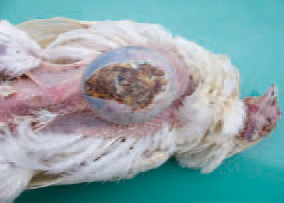
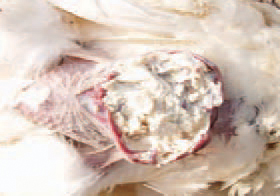
91. 92.. Other local forms of staphylococcosis are sternal bursites. The sternal bursa is enlarged at a various extent because of gathering of purulent substance. Sometimes, the covering skin is necrotized. The microorganism is widely distributed in the environment and mainly on the skin. Most of Staphylococcus oureus-induced lesions are associated with skin injuries, debeaking, finger cuts. All categories of birds are affected. Toxicogenic strains are able to induce food intoxications.
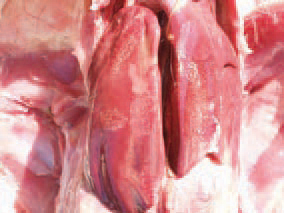
93. In a septicaemic staphylococcal infection, hyperaemia, enlargement and various-degree coagulation necroses in the liver or the spleen are observed. As staphylococci are ubiquitous, their presence could not be prevented. The measures should be directed toward minimizing the possibilities for traumas of skin, respiratory and intestinal mucosa.
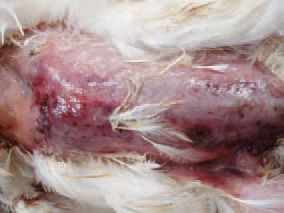
94. A typical secondary infection is staphylococcal gangrenous dermatitis that is usually resulting from immunosuppressive infections (IBD, CIA). Affected skin areas are dark red to blue-greenish, moist and sharply defined from the adjacent healthy skin.
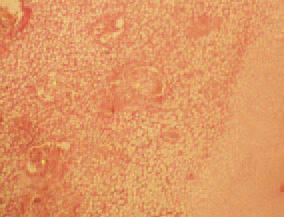
95. Histologically, staphylococcal lesions consist of necroses, bacterial colonization and heterophilic infiltration. The isolation and identification of Staphylococcus spp. confirms the diagnosis. From a differential diagnostical point of view, infections with E. coli, S. gallinarum, P. multocida, M. synoviae and reoviruses should be considered.
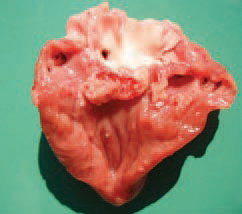
96. . Streptococcosis in poultry is encountered as acute septicaemia or chronic infections with a death rate between 0.5 and 50%. The agent that is most commonly associated with several pathological conditions in poultry is 5. zooepidemicus. The lesions in chronic streptococcal infections include arthrites, tenosynovites, myocardites and valve endocardites. Endocardites affect predominantly mitral valves and less frequently, aortal and tricuspid valves.

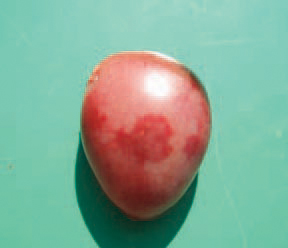
97. 98. Other lesions related to endocardites, are heart, liver and spleen infarctions. Liver infarctions are usually peripherally located on margins, have a pale creamy colour and are sharply demarcated. The penetration of the infection occurs mainly via the oral or aerogenic route, but could also enter through the injured skin, especially in battery cage layer hens. The differential diagnosis includes other bacterial septicaemias as staphylococcosis, fowl cholera, E. coli infections etc.






